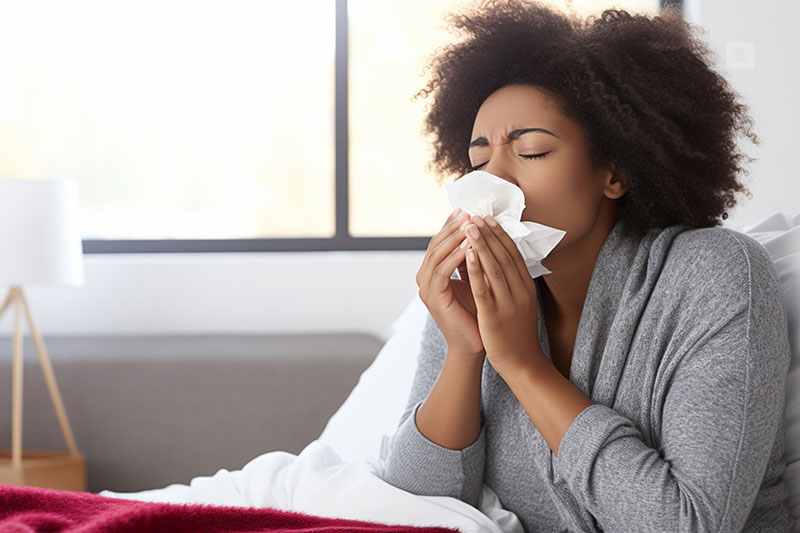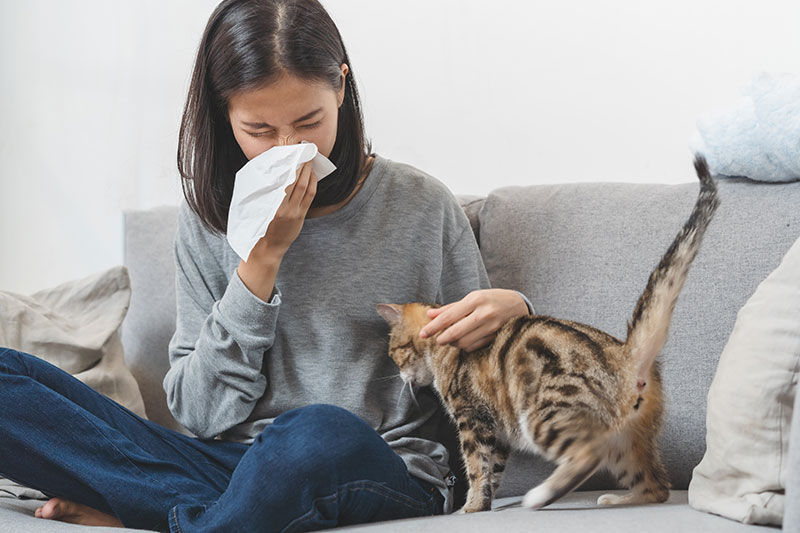Welcome to the News & More section. Here you will find general information in the form of press releases, news and the latest graphical material.
Allergies
What is an allergy?
Around 30 percent of people in Germany aged 18 to 79 develop an allergy at some point in their lives. 1 Estimates by the World Health Organisation even suggest that one in two people will be affected by an allergy by 2050.2
Despite the large number of people affected by allergies, their root causes are still not fully understood. However, we know that an immune system disorder is involved. Allergies occur following repeated contact with an allergen, a substance that triggers an allergy such as pollen. The initial contact may “sensitise” the body to an allergen. The immune system is then activated the next time the person comes into contact with it. Once activated, it releases various inflammatory messenger substances, including histamine. Release of these messenger substances causes the allergic reaction.3 If left untreated, allergies can become more severe over time, the body can become sensitised to a wider range of stimuli and the risk of asthma can increase.4,5
Symptoms of an allergic reaction can be very varied and they can have a severe impact on people’s quality of life. Sleep, social life and everyday activities are impaired by symptoms such as swollen and itchy eyes, a runny or stuffy nose, sneezing or coughing and even difficulty breathing.4,6 Symptoms may also include itchy, reddened skin.
What are the triggers?
Pollen, dust mites, animal hair or moulds are some of the most common allergens. People also suffer from food allergies or insect venom allergies.
Hay fever:
- Many people are allergic to pollen, which is produced by plants when they start to flower. Pollen allergy, also known as hay fever, is actually a seasonal allergy. However the “pollen-free” period of the year is becoming increasingly shorter, making life for people with pollen allergies increasingly difficult. Pollen levels and pollen allergenicity are also increasing. Apart from the disease burden due to the allergy itself there is also a risk that a pollen allergy may develop into allergic asthma.4

House dust mites:
- House dust mite allergy is often referred to colloquially as simply “house dust allergy”. However it actually involves sensitisation to the faeces of house dust mites, not house dust. These microscopically small arachnids live in dust and feed on the dead flakes skin (dander) it contains. Since house dust mites occur throughout the year, house dust mite allergy is classed as a year-round allergy, with symptoms becoming more severe at the start of the heating period.7 The long-term exposure this involves means it can be a trigger for asthma.

Animal hair:
- People with an animal hair allergy are not allergic to the animal hair itself but to protein in the animals’ saliva or dead flakes of skin (dander). These allergens also often adhere to the animal hair and spread easily to cushions, clothing and other surfaces. Symptoms mostly occur soon after contact with the animal, so it is generally easy to identify the trigger of an animal hair allergy.

Moulds:
- Moulds and their spores are omnipresent throughout the year, both in the soil and indoors. Moulds perform important functions in nature. Their spores can become airborne and spread into our homes. If humidity levels in rooms are high, they can become established there, too. So mould allergies can be triggered both indoors and outdoors, with people at greater harm in rooms infested with mould.
A doctor should be consulted in cases of a suspected allergy so that the allergen can be identified and a suitable course of treatment selected.
How are allergies treated?
An important pillar in the treatment of allergies is allergen elimination. This involves consistently avoiding the allergen, which is only possible to a limited degree in the case of pollen allergy, for example.
There are a number of drugs available to treat allergies. Depending on the severity and nature of the symptoms, chromones (mast cell stabilisers), leukotriene receptor antagonists, antihistamines or corticosteroids can be used.8,9 Antihistamines are the treatment of choice for mild allergy symptoms and are classed as antiallergic medication. They prevent the allergic reaction from occurring in the body, which alleviates acute allergic symptoms.
If symptoms persist, or are moderately severe to severe, intranasal corticosteroids, which have an anti-inflammatory effect, are also used.
If treatment with drugs from a single substance category is not enough, combination drugs may also be used.9 Additionally, hyposensitisation can be conducted. This is a process that takes around three years to complete and aims to habituate the body to the allergens in order to reduce symptoms over the long term. 11
Sources:
1Schmitz R, et al. Journal of Health Monitoring, 2017; 2(1): 77-82
2Dbouk T, et al. Sci Rep, 2022; 12(1): 21076
3Entstehung von Allergien - Allergieinformationsdienst (Last accessed:25.01.2024)
4https://www.mein-allergie-portal.com/pollenallergie-heuschnupfen/30-heuschnupfen.html (Last accessed: 25.01.2024)
5Bousquet J, et al. Nat Rev Dis Primers, 2020; 6(1): 95
6Makatsori M, et al. Current Treatment Options in Allergy, 2014; 1: 27–38
7https://www.ecarf.org/heizsaison-ist-milbensaison
8https://www.gesundheitsinformation.de/welche-medikamente-koennen-heuschnupfen-lindern.html
9Klimek L. et al., Allergo J Int, 2019; 28: 255–276.
10Leceta A. et al., Drugs Context, 2021; 10: 2021-5-1. Müdigkeit und Schläfrigkeit in Studien mit vergleichbarer Häufigkeit wie unter Placebo.
11https://www.daab.de/allergien/wichtig-zu-wissen/behandlung/hyposensibilisierung/ (Last accessed 19.03.2024)















